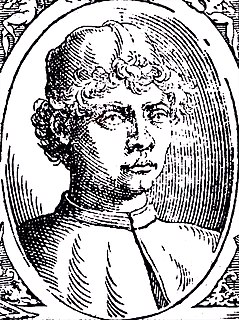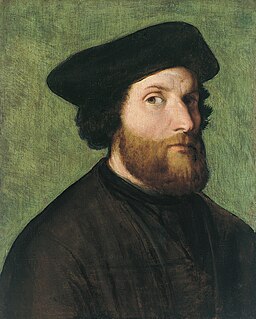
Piero della Francesca, originally named Piero di Benedetto, was an Italian painter of the Early Renaissance. To contemporaries he was also known as a mathematician and geometer. Nowadays Piero della Francesca is chiefly appreciated for his art. His painting is characterized by its serene humanism, its use of geometric forms and perspective. His most famous work is the cycle of frescoes The History of the True Cross in the church of San Francesco in the Tuscan town of Arezzo.

Lorenzo Lotto was an Italian painter, draughtsman, and illustrator, traditionally placed in the Venetian school, though much of his career was spent in other north Italian cities. He painted mainly altarpieces, religious subjects and portraits. He was active during the High Renaissance and the first half of the Mannerist period, but his work maintained a generally similar High Renaissance style throughout his career, although his nervous and eccentric posings and distortions represented a transitional stage to the Florentine and Roman Mannerists.

Lorenzo di Credi was an Italian Renaissance painter and sculptor best known for his paintings of religious subjects. He is most famous for having worked in the studio of Andrea del Verrocchio at the same time as the young Leonardo da Vinci.

Benvenuto Tisi was a Late-Renaissance-Mannerist Italian painter of the School of Ferrara. Garofalo's career began attached to the court of the Duke d'Este. His early works have been described as "idyllic", but they often conform to the elaborate conceits favored by the artistically refined Ferrarese court. His nickname, Garofalo, may derive from his habit of signing some works with a picture of a carnation.

Fossombrone is a town and comune in the province of Pesaro e Urbino, Marche, central Italy.

Cagli[ˈkaʎʎi] is a town and comune in the province of Pesaro e Urbino, Marche, central Italy. It c. 30 kilometres south of Urbino. The Burano flows near the town.

Olivuccio Ceccarello di Ciccarello was an Italian painter. Little is known of his life. He was a native of Camerino and was active from 1388 until his death. In 2002 works formerly attributed to an obscure painter named Carlo da Camerino were re-attributed to Olivuccio di Ciccarello as it had become clear Carlo da Camerino had never existed.

The Pinacoteca Nazionale is a national museum in Siena, Tuscany, Italy. Inaugurated in 1932, it houses especially late medieval and Renaissance paintings from Italian artists. It is housed in the Brigidi and Buonsignori palaces in the city's center: the former, built in the 14th century, it is traditionally identified as the Pannocchieschi family's residence. The Palazzo Bichi-Buonsignori, although built in the 15th century, has a 19th-century neo-medieval façade based on the city's Palazzo Pubblico.

The Pinacoteca del Castello Sforzesco is an art gallery in the museum complex of the Castello Sforzesco in Milan, northern Italy.

The Pinacoteca Comunale ofCittà di Castello is the main museum of paintings and arts of Umbria Italian Region, alongside the Perugia's National gallery, and it's housed in a renaissance palace, generally preserved in its original form.

Santa Croce in Fossabanda is a Renaissance-style Roman Catholic church and monastery in Pisa, region of Tuscany, Italy.
Pietro di Domenico da Montepulciano was an Italian painter active in the Marche region.

Museo Civico di Teramo is an art museum in Teramo, Abruzzo.

San Francesco is a Gothic-style, Roman Catholic, Franciscan church in Cagli, province of Pesaro e Urbino, region of Marche, Italy.
San Domenico is a deconsecrated Roman Catholic church in the town of Fano, province of Pesaro and Urbino in the Marche, Italy. The deconsecrated church is now used to display the painting collection of the Fondazione Cassa di Risparmio di Fano. The church has been selected to display sacred works and altarpieces from the 16th and 17th centuries in an environment resembling their original placements.
Antonio da Faenza was an Italian painter and architect active in Emilia-Romagna and Marche, active in a Renaissance style. The documentation on Antonio da Faenza is confused because, different authors have referred to him by various names including:

Fossombrone Cathedral is a Roman Catholic cathedral dedicated to Saint Aldebrandus and Saint Augustine located in the Piazza Mazzini at the end of Corso Garibaldi in the center of the town of Fossombrone in the province of Pesaro and Urbino in the region of Marche, Italy. Formerly the cathedral of the Diocese of Fossombrone, since 1986 it has been a co-cathedral of the Diocese of Fano-Fossombrone-Cagli-Pergola.
The Diocesan museum of Padua displays arts and artifacts belonging to the Roman Catholic Diocese of Padua; it is housed in the 15th-century former bishop's residence or Palazzo Vescovile. The building, adjacent to the Cathedral of Padua, faces the Piazza del Duomo, can in the historic center of Padua, region of Veneto, Italy.

The Museo Civico di Montepulciano, also known as the Museo Civico Pinacoteca Crociani, is the town or comune art gallery and museum. It is housed in the medieval Palazzo Neri Orselli, a 14th-century structure located on Via Ricci #10, corner with Via Talosa, in the center of the town of Montepulciano, in the Province of Siena, region of Tuscany, Italy. The museum was founded in 1954.

The Musei Civici di Padova or degli Eremitani is a complex of museums and historic sites, centered on the former convent of the Eremitani, and its famous Cappella degli Scrovegni with its Giotto fresco masterpieces. The complex is located on Piazza Eremitani, at the edge of the historic center of Padua, region of Veneto, Italy. The complex includes halls of archaeological objects and – in the nearby Palazzo Zuckermann – a museum of modern and medieval applied art.















